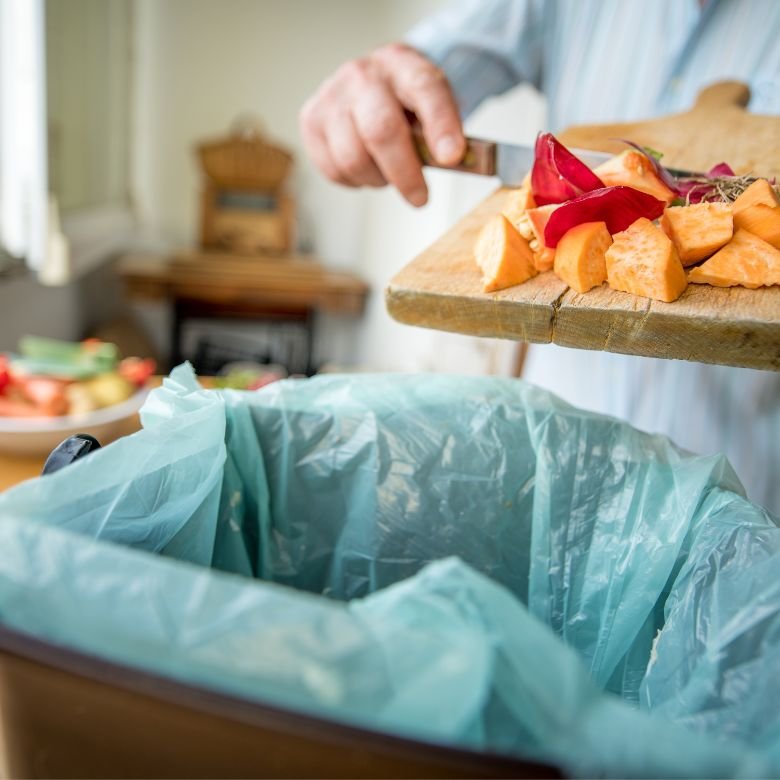According to Statistics Poland, an average Pole produces over 300 kg of waste per annum, a large part of which is organic waste. Unfortunately, many people do not know how to properly segregate it and how to dispose of bio-waste. What to use to pack food leftovers, peels, or leaves? We have prepared a set of practical guidelines.

What is biodegradable waste and where to dispose it?
Biodegradable waste is such waste that is subject to the natural process of decomposition with the help of micro-organisms such as bacteria, protozoa, algae, or fungi. Examples of bio-waste include peels, dregs, leaves, food leftovers, eggshells, or mowed grass. The category of biodegradable waste does not include meat, bones, animal excrement, processed wood, ash, or soil.
Can a bio-waste container be of any colour? As it turns out, no; the marking and colours of waste containers are regulated by the law. The Regulation of the Minister of Climate and Environment of 10 May 2021 on the method of separate collection of selected waste fractions sets the following guidelines:
- biodegradable waste should be stored in brown containers or brown bags,
- the bags or containers should bear the ‘BIO’ mark.
The Regulation concerns house owners and property managers. In practice, the obligation to segregate waste applies to all residents who, however, do not know what to put their waste in. Can bio-waste be disposed of in bags, and if so, then in what bags? Some use plastic bags, others choose paper bags or even used shop bags. What should proper segregation look like? Let’s check.
Can plastic bags be used to dispose of bio-waste?
In everyday life, many people do not bother about whether bio-waste can be disposed of in plastic bags. Unfortunately, the waste is usually put into plastic bags that are neither ecological nor biodegradable. Contaminated plastic bags are often non-recyclable, so they should not be used for organic waste.
Plastic bags pose a serious problem in bio-waste sorting plants. They are often crumpled and stuck to food leftovers etc., which makes their selection difficult or even prevents further treatment of large batches of organic waste. In the worst case scenario, bio-waste that is heavily contaminated with plastics is sent to landfills where it remains for years.
What to use to dispose of bio-waste?
Where to search for a hint on what to put bio-waste in? Instructions are usually available on waste containers and bin shelters (if the bins are public) as well as on the websites of utility companies involved in waste collection. Presently, biodegradable waste bags are recommended for disposing of bio-waste.
What is a biodegradable bag? It is a waste bag that is produced from organic materials and is made of materials that biodegrade quickly. Such a bag decomposes in around 30–45 weeks, so it is not harmful to the natural environment. The production of special bio-waste bags uses plant-based raw materials, mainly maize starch.
Can we use paper bags for bio-waste?
Paper bags for bio-waste are increasingly more popular in Polish homes. Are they a good solution? Yes, if we choose the appropriate type. What to use to dispose of biodegradable waste; what paper bag to buy? You should choose compostable and 100% biodegradable bags marked with an appropriate certificate. They are an excellent alternative to plastic bags.
You should remember, however, that greasy and dirty paper is not suitable for recycling; it can only be processed into biomass or compost. Another issue is the lack of knowledge about where to dispose of full bio-waste bags. Some communes recommend throwing paper bags into mixed-waste containers. Others suggest putting biodegradable bags into the brown containers.

What can we replace biodegradable waste bags with?
Before plastic bags and biodegradable bags in particular became commercially available, waste had been thrown directly from the bin to the container. To date, it remains the most ecological way to dispose of bio-waste produced by households, enterprises, etc. Throwing waste directly into collective containers facilitates the segregation process at municipal waste collection facilities. Biological waste can then be more easily transformed into valuable biomass or compost.
Instead of buying disposable, small biodegradable bags, we can invest in a special bin with a handle and a tight cover. Bio-waste should be thrown into eco-bins produced of recycled materials.
How to dispose of bio-waste? Useful guidelines
The rules of segregating organic and other waste keep changing. This is why you should regularly check the websites of local waste collection companies for how to properly dispose of bio-waste, what type of bag to use and what to do with it once it has been used.
When removing waste, you should apply a few good and ecological practices:
- empty the bio-waste bag carefully and then throw it into the appropriate container,
- if you place your waste in a paper bag and additionally protect it with a plastic bag, make sure that both bags are put into appropriate containers (for plastics and mixed waste).
Attach stickers or paper sheets to your waste bins with instructions on what to throw into the bio-waste container. A handy list will make it easier for all household members to segregate the waste efficiently.
- https://naszesmieci.mos.gov.pl/jak-segregowac/73-odpady-biodegradowalne
- https://www.gdansk.pl/urzad-miejski/wiadomosci/bioodpady-wrzucaj-bez-worka,a,244773
